
views
Reading and Understanding the Exam

Listen carefully to the teacher’s instructions. Before you start reading through the exam, look up to the front of the room (or wherever your teacher is located) and listen to their instructions. Pay careful attention to any instructions about the exam that your teacher emphasizes. Your teacher might emphasize something by repeating it or making a note of it on the board. You should also make a note of anything that your teacher says that might help you take the exam. For example, if your teacher mentions that there is no penalty for guessing if you do not know the answer, then you will know that you should answer every question on the exam. Make sure to ask questions if anything is unclear about what your teacher says. They will likely provide an opportunity for you to ask questions, but if not, raise your hand!
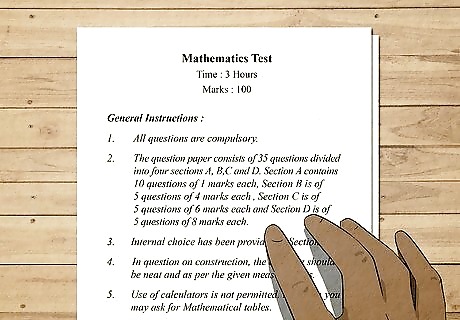
Read through the test 1 time before answering any questions. A complete read-through is essential because it allows you to preview the information in the exam, start thinking about how you will answer certain questions, and identify any questions that you don’t understand. Read through the entire exam 1 time and jot down notes about anything important you think of during this read-through. For example, if you come across a question that is worded in a way that does not make sense to you, make a note about it and ask your teacher to clarify.
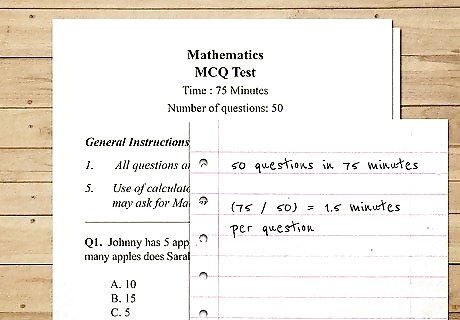
Determine how much time to spend on each question. Depending on how much time you have to complete the exam and how many questions there are, you might have a tight schedule to keep. Don’t spend too much time determining how long to spend on each question. Just do a quick estimate. For example, if the exam has 50 multiple choice questions, and you have 75 minutes to take the exam, then you will have about 1.5 minutes per question. Make sure to allocate extra time for essay questions. For example, if you have 60 minutes to answer 30 multiple choice questions and 2 essay questions, then you should probably plan to devote 1 minute to each multiple choice question and allow yourself 15 minutes per essay question.
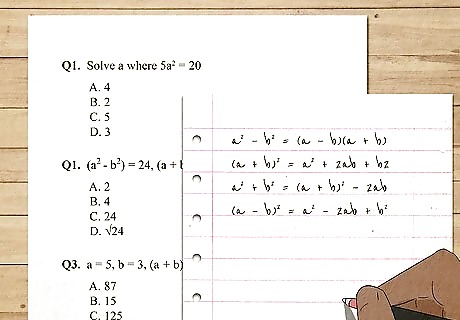
Write down anything you are worried you might forget. Before you start filling in answers, you might find it helpful to write down any information that you will need to answer certain questions and that you are worried you might forget by the time you get to them. For example, you could write down mathematical formulas you will need, facts that you can include in an essay answer, or the dates of some important events that you noticed in the multiple choice section.
Answering Difficult Questions on the Exam
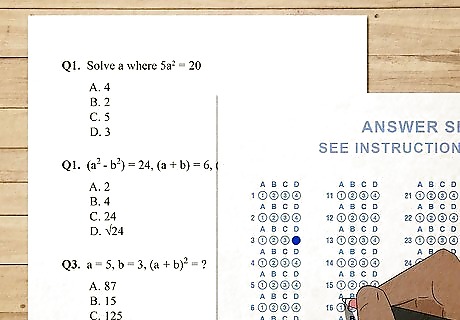
Answer the easiest questions first and skip the rest. Start by answering questions that you know the answers to and skip the other questions. You can come back to them later. This will help to give you some momentum and build your confidence for tackling the more difficult parts of the exam. It will also help to improve the chances that you will pass by ensuring that you get maximum points possible. For example, if you know the answers to some of the multiple choice questions, answer those questions first and skip over the ones you don’t know. Return to the questions you skipped only after you have finished answering the ones you know.
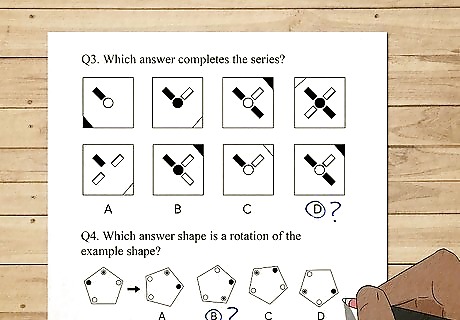
Guess on tough questions if there is no penalty for incorrect answers. If you get stuck on a question that you do not know the answer to, then you might just have to guess. However, make sure that you will not be penalized for entering an incorrect answer. If this is the case, then you might be better off leaving these questions blank. A penalty means that you will receive an additional points deduction for incorrect responses. For example, if you will receive an additional deduction for answering incorrectly, but you will only receive zero credit if you leave it blank, then leave it blank.
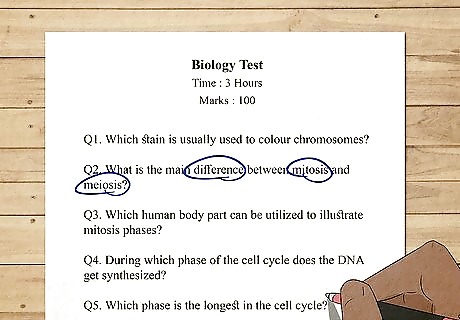
Circle keywords in difficult questions. If you come across a question that you do not know the answer to, you might be able to improve your chances of getting it right by circling the keywords. Circle any words that stand out to you as important terms and see if this helps you to understand and answer the question. For example, if the question is, “What is the main difference between mitosis and meiosis?” then the keywords are “difference,” “mitosis,” and “meiosis.” You would want to focus on these terms to determine how to answer the question.

Rewrite difficult questions in your own words. If you come across a question that is worded in a way that is hard for you to comprehend, try rewriting the question in your own words. This may help to give you some clarity on what the question is asking and how best to answer it. For example, if the question asks, “What was the most notable achievement of Louis Pasteur that also shares his name?” then you might rewrite the question to, “What important thing did Louis Pasteur do that is named after him?”

Review your answers and add more detail if there's time to spare. Once you have finished answering all of the questions on the exam, you might have a little time to spare. If you do, then go back through the exam and review your answers. Focus on the questions that you were unsure about or that you only answered in minimal detail. Add detail and clarify your answers as much as possible. Depending on how much time you have left, you may have to target your review. For example, if you finish with 10 minutes to spare, you might have time to quickly read through your whole exam. However, if you finish with 2 minutes to spare, then you might just choose to review a few questions that you felt unsure about.
Tackling Multiple Choice Questions
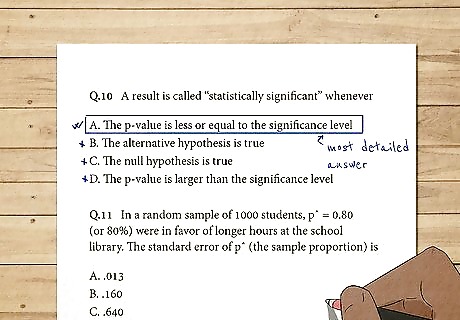
Choose the most detailed answer option provided. If the question is multiple choice, then opt for the answer to the question that is the longest and most specific. This is often the correct response. For example, if the question provides a short, vague answer for a few of the options and then a longer, more detailed option answer for 1 of the options, then the longer answer is likely correct. Sometimes, lengthy and over-detailed answers are purposefully written on the test to trick you into believing it’s the best answer. Use your best judgment to determine if the answer fits the question best.
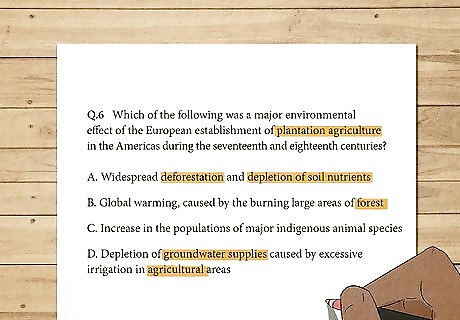
Look for linguistic commonalities between the questions and answers. The right answer is often grammatically correct when read along with the question and/or shares similar language with the question. Read the question and then read each of the answers in response to it to see which answer sounds correct. For example, if the question uses the past tense and only 1 of the answers is written in the past tense, then this might be the correct answer. Likewise, if the question features certain terms that 1 answer also includes, then this may be the correct answer.
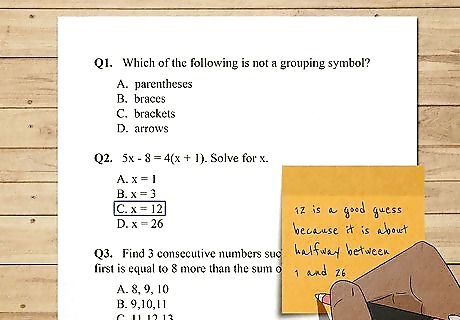
Select the numerical choice in the mid-range of the options. If you are trying to find the correct numerical answer, choose a number in the middle of the range of number choices provided. For example, if the possible answers are 1, 3, 12, and 26, then 12 is a good guess because it is about halfway between 1 and 26.
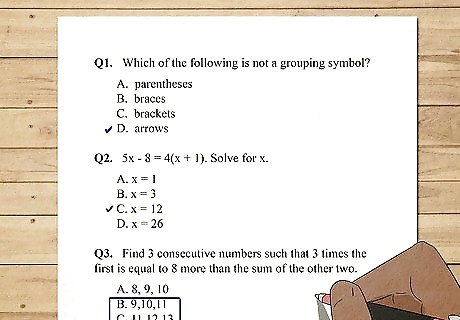
Select C or B if you just don’t know. When in doubt, choose C or B on multiple test questions. C is the most common answer on multiple choice exams, and B is the second most common answer. Choose C if you are unsure which answer to choose, and choose B if C seems incorrect. For example, if you come across a question that you have no idea what the correct answer could be, then choose C. However, if you think C is incorrect but can’t decide which of the other responses might be right, then choose B.
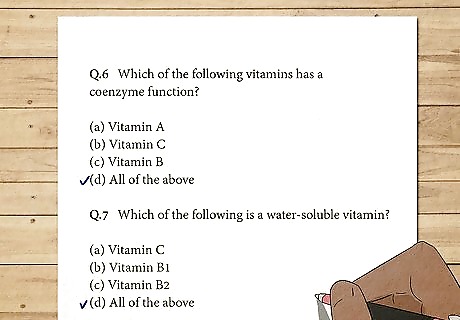
Select “all of the above” when it’s offered, but avoid “none of the above.” “None of the above” is rarely the right answer, but “all of the above” is often correct. Using this rule can help you to narrow your choices if you are unsure of how to answer a question. For example, if you are unsure of the answer to a question and “all of the above” is an option, then choose it. If “none of the above" is offered, then you can eliminate that as a possible correct response and focus on your other options.
Choosing the Best Answer on True/False Sections
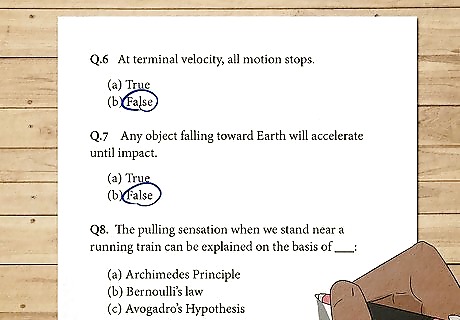
Choose false if the statement includes absolute qualifiers. Statements that include absolute qualifiers are rarely true, so choose false when you come across these types of statements. Absolute qualifiers include words like: No Never None Every All Always Entirely Only

Select true for statements with less extreme qualifiers. If a statement features a qualifier that is not absolute and that seems more reasonable, then it is likely true. Less extreme qualifiers include: Seldom Sometimes Frequently Most Many Usually Some Few Generally Ordinarily
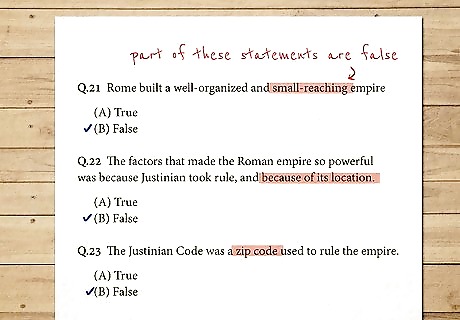
Pick false if any part of the statement is false. It does not matter if the entire statement is false or just 1 word or phrase in the statement is false. If any part of a statement is false, then choose false as your answer. For example, if a statement is mostly true except for 1 word, then it is false.

Watch out for words that can change the meaning of the statement. Certain words can alter what a statement means, so it is important to watch out for these and consider how they affect the statement. A single word might render the statement true or false. Some words to pay attention to include: So Therefore Because Consequently As a result Thus Not/cannot/can’t Won’t Don’t
Improving Your Mental State for the Exam

Get a good night’s sleep. Being well-rested will improve your chances of performing well on an exam, even if you have not studied for it! You will think more clearly and be less likely to make simple mistakes due to being tired. Got to bed on time the night before you have to take an exam. For example, if you normally go to bed at 10:00 pm, make sure you are in bed at 10:00 pm.

Eat breakfast the day of the exam. Taking an exam on an empty stomach is a bad idea because you will likely have more difficulty concentrating if your stomach is growling. Eat a good breakfast the morning of the exam to help fuel your brain and keep you focused. Some good breakfast options include: A bowl of oatmeal with fresh berries, walnuts, and brown sugar A hard-boiled egg, 2 slices of buttered whole wheat toast, and a banana Cottage cheese, fruit salad, and a bran muffin
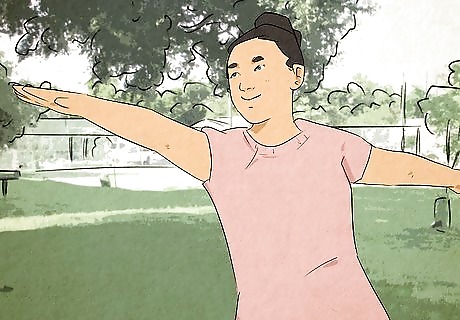
Use a relaxation technique to calm down. Feeling stressed may cause you to freeze or panic while taking an exam, and this may affect your ability to complete it. Use a relaxation technique to get into a calm state of mind prior to taking the exam, and you will likely perform better. Some techniques to try include: Try meditating Do some yoga Take deep breaths Perform a progressive muscle relaxation exercise
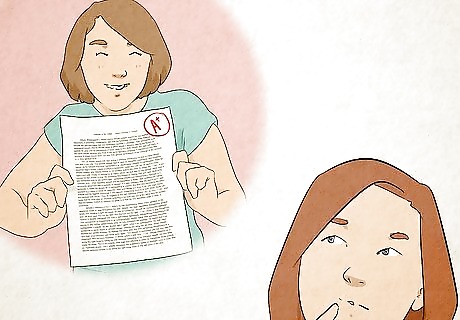
Visualize yourself passing the test. Positive visualization may help to improve your chances of passing a test, and it can also help to alleviate some of your test-taking anxiety. Before you head into the exam, close your eyes and imagine yourself receiving the test back with a passing grade on it. Spend at least a few minutes focusing on this vision. The more detailed you can make your visualization the better! Focus on the way the passing grade will look on the paper, your teacher’s reaction, and how you will feel after receiving a passing grade.
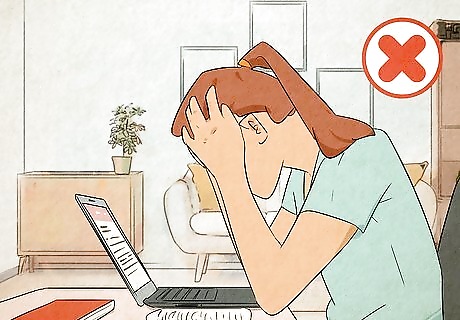
Avoid cramming for the test. Ideally, you will have studied for weeks or even months leading up to an exam, but things don’t always work out that way. If you meant to study but didn’t and are now facing an important exam that you feel unprepared to take, cramming probably won’t help you. You are better off taking the exam with what you know right now. If you don’t do well on the exam, focus on studying for the next exam!



















Comments
0 comment